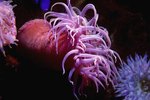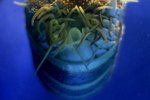
Krill and plankton are two groups of organisms found in the ocean. Krill are species of crustacean related to shrimp, and serve as a very important link in the food chain of the sea. Plankton consist of a larger group of organisms with much more variety, including bacteria, algae, protozoans, jellyfish and some species of cephalopods.
Propulsion
The primary factor that determines whether a species is plankton or not is propulsion. Plankton organisms lack the ability to swim against the tide, and instead float from place to place on sea currents. They may be capable of some movement, and some types of plankton can even hunt for food, but none is powerful enough to make its own headway through the ocean. Adult krill are capable of swimming against currents, but their larvae and eggs fall into the plankton category.
Variation
Krill are crustaceans of the Euphausiacea order, which consists of 86 different species. Plankton, on the other hand, can come from a wide variety of different species and orders. Plankton fall into three broad categories, depending on their primary function. Phytoplankton are plant-like organisms, capable of photosynthesis. Zooplankton are animal plankton species that get their nutrients by eating other microscopic organisms. Bacterioplankton are the smallest plankton, and often serve as food for zooplankton and other lifeforms.
Appearance
Krill species have similar characteristics and generally resemble tiny shrimp. Most species reach around 2 centimeters (0.8 inches) as adults, while the largest species can reach sizes of up to 15 centimeters (5.9 inches). Plankton, on the other hand, consists of organisms of many different shapes and sizes. The smallest categories include microscopic viruses, protozoans, small crustaceans, and other tiny organisms. At the larger end of the scale, megaplankton are any plankton over 2 centimeters (0.8 inches) in size, and include large animals, such as cephalopods and jellyfish. The largest plankton is the lion's mane jellyfish, which can reach 2.5 meters (8.2 feet) in diameter and grow tentacles more than 36.5 meters (120 feet) long.
Role
Plankton and krill serve similar, but slightly different, roles in the food chain. Phytoplankton synthesize nutrients, while bacterioplankton recycle nutrients from decomposing matter in the ocean, providing some of the fundamental sources of nutrition for all ocean creatures. Zooplankton serve to concentrate those nutrients by eating smaller plankton and serving as food for larger creatures. Krill are one step up in the food chain, eating plankton and serving as a nutrient bridge from microscopic life forms to larger fish and mammals.
References
Photo Credits
-
Photos.com/Photos.com/Getty Images
Writer Bio
Milton Kazmeyer has worked in the insurance, financial and manufacturing fields and also served as a federal contractor. He began his writing career in 2007 and now works full-time as a writer and transcriptionist. His primary fields of expertise include computers, astronomy, alternative energy sources and the environment.



